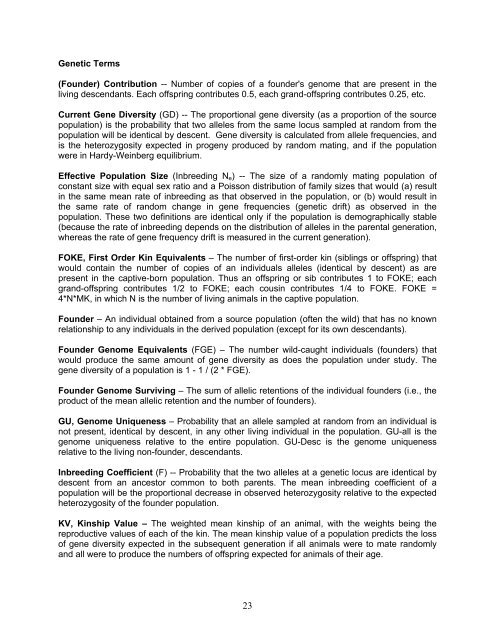National Studbook of Indian Wild Ass - Central Zoo Authority
National Studbook of Indian Wild Ass - Central Zoo Authority
National Studbook of Indian Wild Ass - Central Zoo Authority
Create successful ePaper yourself
Turn your PDF publications into a flip-book with our unique Google optimized e-Paper software.
Genetic Terms<br />
(Founder) Contribution -- Number <strong>of</strong> copies <strong>of</strong> a founder's genome that are present in the<br />
living descendants. Each <strong>of</strong>fspring contributes 0.5, each grand-<strong>of</strong>fspring contributes 0.25, etc.<br />
Current Gene Diversity (GD) -- The proportional gene diversity (as a proportion <strong>of</strong> the source<br />
population) is the probability that two alleles from the same locus sampled at random from the<br />
population will be identical by descent. Gene diversity is calculated from allele frequencies, and<br />
is the heterozygosity expected in progeny produced by random mating, and if the population<br />
were in Hardy-Weinberg equilibrium.<br />
Effective Population Size (Inbreeding Ne) -- The size <strong>of</strong> a randomly mating population <strong>of</strong><br />
constant size with equal sex ratio and a Poisson distribution <strong>of</strong> family sizes that would (a) result<br />
in the same mean rate <strong>of</strong> inbreeding as that observed in the population, or (b) would result in<br />
the same rate <strong>of</strong> random change in gene frequencies (genetic drift) as observed in the<br />
population. These two definitions are identical only if the population is demographically stable<br />
(because the rate <strong>of</strong> inbreeding depends on the distribution <strong>of</strong> alleles in the parental generation,<br />
whereas the rate <strong>of</strong> gene frequency drift is measured in the current generation).<br />
FOKE, First Order Kin Equivalents – The number <strong>of</strong> first-order kin (siblings or <strong>of</strong>fspring) that<br />
would contain the number <strong>of</strong> copies <strong>of</strong> an individuals alleles (identical by descent) as are<br />
present in the captive-born population. Thus an <strong>of</strong>fspring or sib contributes 1 to FOKE; each<br />
grand-<strong>of</strong>fspring contributes 1/2 to FOKE; each cousin contributes 1/4 to FOKE. FOKE =<br />
4*N*MK, in which N is the number <strong>of</strong> living animals in the captive population.<br />
Founder – An individual obtained from a source population (<strong>of</strong>ten the wild) that has no known<br />
relationship to any individuals in the derived population (except for its own descendants).<br />
Founder Genome Equivalents (FGE) – The number wild-caught individuals (founders) that<br />
would produce the same amount <strong>of</strong> gene diversity as does the population under study. The<br />
gene diversity <strong>of</strong> a population is 1 - 1 / (2 * FGE).<br />
Founder Genome Surviving – The sum <strong>of</strong> allelic retentions <strong>of</strong> the individual founders (i.e., the<br />
product <strong>of</strong> the mean allelic retention and the number <strong>of</strong> founders).<br />
GU, Genome Uniqueness – Probability that an allele sampled at random from an individual is<br />
not present, identical by descent, in any other living individual in the population. GU-all is the<br />
genome uniqueness relative to the entire population. GU-Desc is the genome uniqueness<br />
relative to the living non-founder, descendants.<br />
Inbreeding Coefficient (F) -- Probability that the two alleles at a genetic locus are identical by<br />
descent from an ancestor common to both parents. The mean inbreeding coefficient <strong>of</strong> a<br />
population will be the proportional decrease in observed heterozygosity relative to the expected<br />
heterozygosity <strong>of</strong> the founder population.<br />
KV, Kinship Value – The weighted mean kinship <strong>of</strong> an animal, with the weights being the<br />
reproductive values <strong>of</strong> each <strong>of</strong> the kin. The mean kinship value <strong>of</strong> a population predicts the loss<br />
<strong>of</strong> gene diversity expected in the subsequent generation if all animals were to mate randomly<br />
and all were to produce the numbers <strong>of</strong> <strong>of</strong>fspring expected for animals <strong>of</strong> their age.<br />
23

















